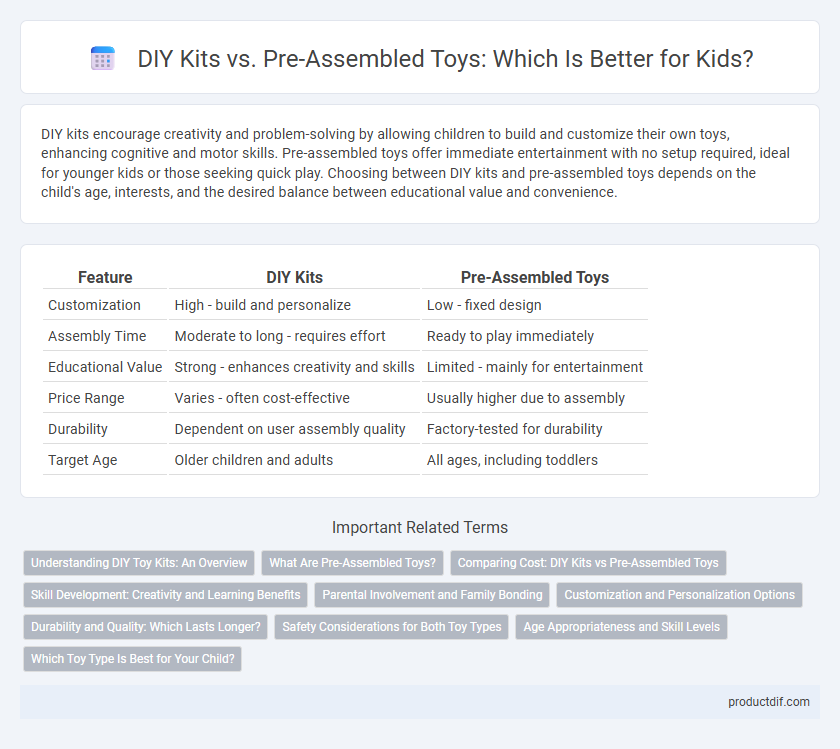DIY kits encourage creativity and problem-solving by allowing children to build and customize their own toys, enhancing cognitive and motor skills. Pre-assembled toys offer immediate entertainment with no setup required, ideal for younger kids or those seeking quick play. Choosing between DIY kits and pre-assembled toys depends on the child's age, interests, and the desired balance between educational value and convenience.
Table of Comparison
| Feature | DIY Kits | Pre-Assembled Toys |
|---|---|---|
| Customization | High - build and personalize | Low - fixed design |
| Assembly Time | Moderate to long - requires effort | Ready to play immediately |
| Educational Value | Strong - enhances creativity and skills | Limited - mainly for entertainment |
| Price Range | Varies - often cost-effective | Usually higher due to assembly |
| Durability | Dependent on user assembly quality | Factory-tested for durability |
| Target Age | Older children and adults | All ages, including toddlers |
Understanding DIY Toy Kits: An Overview
DIY toy kits offer hands-on learning experiences that enhance creativity, problem-solving skills, and fine motor development in children. These kits typically include all necessary materials and instructions, allowing kids to build toys such as robots, models, or puzzles from scratch. Compared to pre-assembled toys, DIY kits provide educational value by encouraging active engagement and fostering STEM (Science, Technology, Engineering, and Mathematics) skills.
What Are Pre-Assembled Toys?
Pre-assembled toys are ready-to-play products manufactured and packaged for immediate use without the need for assembly or additional tools. These toys offer convenience and time savings, ideal for younger children or those lacking patience for construction. Brands like LEGO and Fisher-Price provide pre-assembled options, ensuring durability and safety standards are met out of the box.
Comparing Cost: DIY Kits vs Pre-Assembled Toys
DIY kits often cost less upfront than pre-assembled toys due to simplified packaging and bulk material purchasing. Pre-assembled toys can incur higher expenses from labor, quality control, and branding, which elevate retail prices. Choosing DIY kits also offers value through educational engagement and customization potential not typically found in pre-assembled options.
Skill Development: Creativity and Learning Benefits
DIY kits enhance creativity by encouraging children to design, build, and problem-solve, fostering critical thinking and fine motor skills development. Pre-assembled toys offer immediate play but limit opportunities for hands-on experimentation and cognitive growth. Engaging with DIY kits promotes learning through active participation, boosting confidence and innovation in young learners.
Parental Involvement and Family Bonding
DIY toy kits encourage active parental involvement by requiring parents and children to collaborate on building projects, fostering hands-on learning and communication. Pre-assembled toys, while convenient, often limit shared interactive experiences that strengthen family bonding and teamwork. Engaging in DIY kits promotes skill development and creates memorable moments that enhance parent-child relationships.
Customization and Personalization Options
DIY kits offer extensive customization and personalization options, allowing children to build and modify toys according to their preferences and creativity. Pre-assembled toys provide limited personalization, often restricted to cosmetic changes like stickers or paint. Customizable features in DIY kits enhance cognitive development and encourage problem-solving skills through hands-on engagement.
Durability and Quality: Which Lasts Longer?
DIY kits often provide customizability but may vary in durability depending on user assembly skills, whereas pre-assembled toys typically undergo rigorous quality control ensuring consistent sturdiness and longer lifespan. High-quality materials used in pre-assembled toys contribute to greater resistance against wear and tear compared to some DIY kits with weaker components. Consumer reviews and product testing indicate that pre-assembled toys generally maintain structural integrity and safety standards better over time.
Safety Considerations for Both Toy Types
DIY kits often include small parts and require the use of tools, posing choking and injury risks if not properly supervised; toy manufacturers must comply with strict safety standards such as ASTM F963 and EN71 to minimize hazards. Pre-assembled toys undergo rigorous quality control to ensure durability and non-toxic materials, reducing immediate safety concerns, though accidental breakage could expose sharp edges or small components. Parents should always check age recommendations and safety certifications to ensure either toy type is appropriate and safe for their child's developmental stage.
Age Appropriateness and Skill Levels
DIY kits enhance fine motor skills and problem-solving abilities, making them ideal for children aged 7 and above with basic to intermediate crafting skills. Pre-assembled toys offer immediate play value, suitable for younger children aged 3 to 6 who benefit from simple interaction without requiring advanced dexterity. Selecting toys based on age appropriateness and skill levels ensures both safety and developmental benefits.
Which Toy Type Is Best for Your Child?
DIY kits foster creativity, problem-solving skills, and fine motor development by engaging children in hands-on assembly and customization, making them ideal for curious minds. Pre-assembled toys offer immediate play value, convenience, and often more intricate designs that appeal to kids seeking instant entertainment. Choosing the best toy type depends on your child's interests, patience level, and whether you prioritize educational growth or quick play enjoyment.
DIY kits vs pre-assembled toys Infographic

 productdif.com
productdif.com